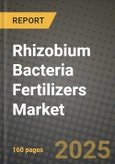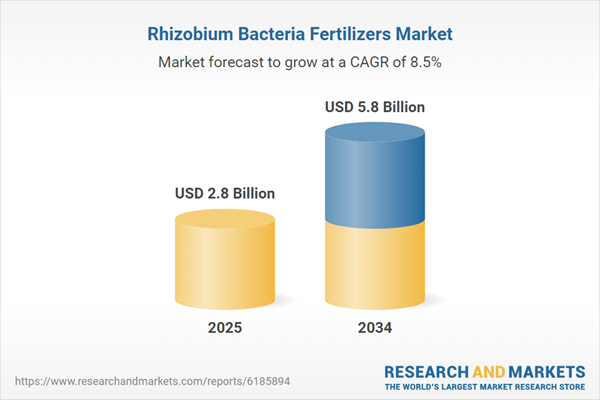The Rhizobium Bacteria Fertilizers Market is gaining strong traction as sustainable agricultural practices become a global priority. These biofertilizers are particularly valued for their ability to naturally fix atmospheric nitrogen in leguminous crops, enhancing soil fertility while reducing dependence on synthetic nitrogen fertilizers. As environmental regulations tighten and farmers seek cost-effective, organic solutions, rhizobium-based inputs have emerged as essential tools in climate-smart agriculture. Their eco-friendly profile and positive impact on soil health are driving adoption in developing as well as developed economies. Key application areas include pulses, oilseeds, and other legumes, especially in regions practicing intercropping and crop rotation. Governments and agricultural organizations are increasingly promoting the use of such microbial inoculants to improve yield and soil sustainability, adding to the momentum of this market.
The market witnessed a noticeable uptick in adoption across Asia-Pacific and Latin America, supported by government subsidies, farmer training programs, and expanding organic farming acreage. India, Brazil, and Indonesia emerged as hotspots, with local producers ramping up rhizobium formulation capacities. Technological advancements led to more robust and shelf-stable formulations, making them viable in varied climatic conditions. Additionally, several agritech startups launched precision application tools and mobile apps for farmer guidance on biofertilizer use. Collaborations between universities and agricultural R&D institutes led to the development of region-specific rhizobium strains, ensuring better compatibility with local soils and crops. The market also saw new players entering with innovative carrier materials, including peat, lignite, and polymer-based delivery systems, improving product longevity and efficacy at the field level.
The Rhizobium Bacteria Fertilizers Market is projected to expand steadily, driven by both environmental and economic imperatives. Integration with precision agriculture platforms will allow for data-driven recommendations, optimizing rhizobium application rates and timing. Demand will also grow among large-scale commercial farms as pressure mounts to reduce greenhouse gas emissions and comply with carbon footprint targets. Emerging innovations, such as encapsulated formulations and biofertilizer blends with multiple microbial strains, will broaden the market’s scope. Additionally, policy shifts - such as carbon credit incentives for sustainable soil practices - could further propel demand. However, widespread education and training will remain key to overcoming farmer skepticism and knowledge gaps, especially in transitioning from chemical to bio-based solutions.
Key Insights: Rhizobium Bacteria Fertilizers Market
- Rising organic farming practices are fueling demand for microbial biofertilizers like rhizobium to meet soil fertility needs without synthetic inputs.
- Innovations in encapsulation and polymer-based carriers are improving the shelf life and field performance of rhizobium formulations.
- Agri-tech integration is enabling precision application of rhizobium fertilizers using GIS mapping, drones, and mobile advisory tools.
- Development of region-specific and climate-resilient rhizobium strains is enhancing microbial compatibility with local crops and soils.
- Public-private partnerships are accelerating farmer education and field trials, increasing trust and practical usage of biofertilizers.
- Increasing awareness about soil degradation and the harmful impact of chemical fertilizers is promoting a shift toward bio-based alternatives.
- Government subsidies, extension services, and organic certification programs are incentivizing the use of rhizobium-based inputs in agriculture.
- Growing demand for sustainable and cost-effective agricultural solutions is driving adoption among both smallholder and commercial farmers.
- Expansion of leguminous crop acreage globally is creating a natural demand base for rhizobium fertilizers as yield-enhancing agents.
- Lack of awareness and technical know-how among farmers regarding the correct application, storage, and handling of rhizobium fertilizers limits their widespread adoption, particularly in remote or low-literacy regions.
Rhizobium Bacteria Fertilizers Market Segmentation
By Type
- Nitrogen-Fixing
- Phosphate-Solubilizing
- Potash-Mobilizing
- Other Types
By Crop Type
- Cereals and Grains
- Pulses and Oilseeds
- Fruits and Vegetables
- Other Crop Types
By Technology
- Carrier Enriched Biofertilizers
- Liquid Biofertilizers
By Application
- Seed Treatment
- Soil Treatment
- Other Applications
Key Companies Analysed
- Yara International Asa
- Nutrien Ltd.
- Eurochem Group Ag
- Lallemand Inc.
- Aumgene Biosciences Pvt. Ltd.
- Cf Industries Holdings Inc.
- Vegalab S.A
- Sinofert Holdings Limited
- Seipasa
- Coromandel International Limited
- Symborg Sl
- Rizobacter Argentina Sa
- Jaipur Bio Fertilizers
- Green Vision Life Sciences Pvt. Ltd.
- Unicrop Biochem
- Criyagen Agri & Biotech Private Limited
- Indian Farmers Fertiliser Cooperative Limited
- Madras Fertilizers Limited
- National Fertilizers Limited
- Novozymes A/S
- Gujarat Bio Organics Pvt. Ltd.
- Nova Agri Tech Ltd.
- Md Biocoals Pvt. Ltd.
- Sln Biologicals Llp
- Harmony Ecotech Pvt. Ltd.
- Manidharma Biotech Pvt. Ltd.
- Nature Agrocare & Research Private Limited
- Terrapreta Agrove
- Utkarsh Agrochem Private Limited
- Tari Bio-Tech
Rhizobium Bacteria Fertilizers Market Analytics
The report employs rigorous tools, including Porter’s Five Forces, value chain mapping, and scenario-based modeling, to assess supply-demand dynamics. Cross-sector influences from parent, derived, and substitute markets are evaluated to identify risks and opportunities. Trade and pricing analytics provide an up-to-date view of international flows, including leading exporters, importers, and regional price trends.Macroeconomic indicators, policy frameworks such as carbon pricing and energy security strategies, and evolving consumer behavior are considered in forecasting scenarios. Recent deal flows, partnerships, and technology innovations are incorporated to assess their impact on future market performance.
Rhizobium Bacteria Fertilizers Market Competitive Intelligence
The competitive landscape is mapped through proprietary frameworks, profiling leading companies with details on business models, product portfolios, financial performance, and strategic initiatives. Key developments such as mergers & acquisitions, technology collaborations, investment inflows, and regional expansions are analyzed for their competitive impact. The report also identifies emerging players and innovative startups contributing to market disruption.Regional insights highlight the most promising investment destinations, regulatory landscapes, and evolving partnerships across energy and industrial corridors.
Countries Covered
- North America - Rhizobium Bacteria Fertilizers market data and outlook to 2034
- United States
- Canada
- Mexico
- Europe - Rhizobium Bacteria Fertilizers market data and outlook to 2034
- Germany
- United Kingdom
- France
- Italy
- Spain
- BeNeLux
- Russia
- Sweden
- Asia-Pacific - Rhizobium Bacteria Fertilizers market data and outlook to 2034
- China
- Japan
- India
- South Korea
- Australia
- Indonesia
- Malaysia
- Vietnam
- Middle East and Africa - Rhizobium Bacteria Fertilizers market data and outlook to 2034
- Saudi Arabia
- South Africa
- Iran
- UAE
- Egypt
- South and Central America - Rhizobium Bacteria Fertilizers market data and outlook to 2034
- Brazil
- Argentina
- Chile
- Peru
Research Methodology
This study combines primary inputs from industry experts across the Rhizobium Bacteria Fertilizers value chain with secondary data from associations, government publications, trade databases, and company disclosures. Proprietary modeling techniques, including data triangulation, statistical correlation, and scenario planning, are applied to deliver reliable market sizing and forecasting.Key Questions Addressed
- What is the current and forecast market size of the Rhizobium Bacteria Fertilizers industry at global, regional, and country levels?
- Which types, applications, and technologies present the highest growth potential?
- How are supply chains adapting to geopolitical and economic shocks?
- What role do policy frameworks, trade flows, and sustainability targets play in shaping demand?
- Who are the leading players, and how are their strategies evolving in the face of global uncertainty?
- Which regional “hotspots” and customer segments will outpace the market, and what go-to-market and partnership models best support entry and expansion?
- Where are the most investable opportunities - across technology roadmaps, sustainability-linked innovation, and M&A - and what is the best segment to invest over the next 3-5 years?
Your Key Takeaways from the Rhizobium Bacteria Fertilizers Market Report
- Global Rhizobium Bacteria Fertilizers market size and growth projections (CAGR), 2024-2034
- Impact of Russia-Ukraine, Israel-Palestine, and Hamas conflicts on Rhizobium Bacteria Fertilizers trade, costs, and supply chains
- Rhizobium Bacteria Fertilizers market size, share, and outlook across 5 regions and 27 countries, 2023-2034
- Rhizobium Bacteria Fertilizers market size, CAGR, and market share of key products, applications, and end-user verticals, 2023-2034
- Short- and long-term Rhizobium Bacteria Fertilizers market trends, drivers, restraints, and opportunities
- Porter’s Five Forces analysis, technological developments, and Rhizobium Bacteria Fertilizers supply chain analysis
- Rhizobium Bacteria Fertilizers trade analysis, Rhizobium Bacteria Fertilizers market price analysis, and Rhizobium Bacteria Fertilizers supply/demand dynamics
- Profiles of 5 leading companies - overview, key strategies, financials, and products
- Latest Rhizobium Bacteria Fertilizers market news and developments
Additional Support
With the purchase of this report, you will receive:- An updated PDF report and an MS Excel data workbook containing all market tables and figures for easy analysis.
- 7-day post-sale analyst support for clarifications and in-scope supplementary data, ensuring the deliverable aligns precisely with your requirements.
- Complimentary report update to incorporate the latest available data and the impact of recent market developments.
This product will be delivered within 1-3 business days.
Table of Contents
Companies Mentioned
- Yara International Asa
- Nutrien Ltd.
- Eurochem Group Ag
- Lallemand Inc.
- Aumgene Biosciences Pvt. Ltd.
- Cf Industries Holdings Inc.
- Vegalab S.A
- Sinofert Holdings Limited
- Seipasa
- Coromandel International Limited
- Symborg Sl
- Rizobacter Argentina Sa
- Jaipur Bio Fertilizers
- Green Vision Life Sciences Pvt. Ltd.
- Unicrop Biochem
- Criyagen Agri & Biotech Private Limited
- Indian Farmers Fertiliser Cooperative Limited
- Madras Fertilizers Limited
- National Fertilizers Limited
- Novozymes A/S
- Gujarat Bio Organics Pvt. Ltd.
- Nova Agri Tech Ltd.
- Md Biocoals Pvt. Ltd.
- Sln Biologicals Llp
- Harmony Ecotech Pvt. Ltd.
- Manidharma Biotech Pvt. Ltd.
- Nature Agrocare & Research Private Limited
- Terrapreta Agrove
- Utkarsh Agrochem Private Limited
- Tari Bio-Tech
Table Information
| Report Attribute | Details |
|---|---|
| No. of Pages | 160 |
| Published | October 2025 |
| Forecast Period | 2025 - 2034 |
| Estimated Market Value ( USD | $ 2.8 Billion |
| Forecasted Market Value ( USD | $ 5.8 Billion |
| Compound Annual Growth Rate | 8.4% |
| Regions Covered | Global |
| No. of Companies Mentioned | 30 |









